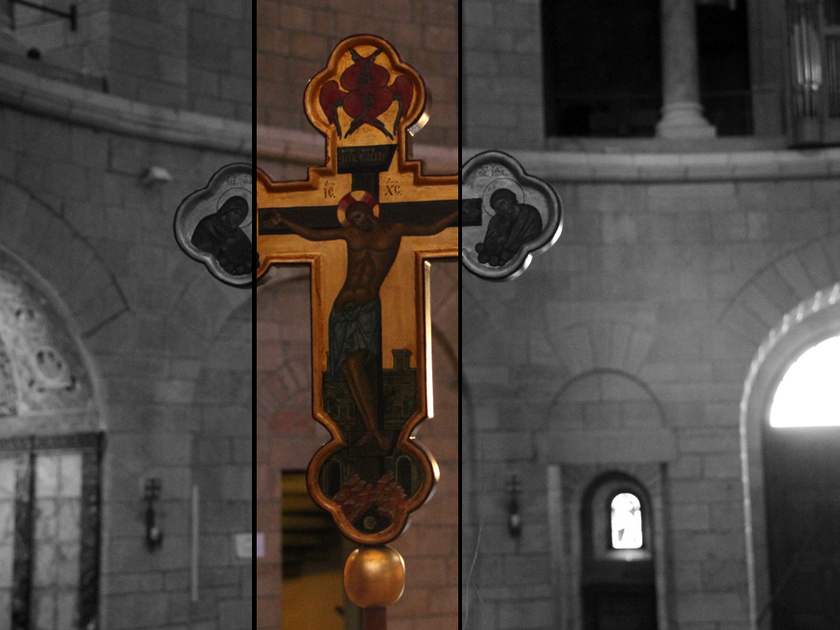Christ – the true high priest
28. Oktober 2012
Homily for the 30th Sunday in Ordinary Time, 2012 (October 28 2012), Abbot Gregory Collins
 Ikonenkreuz in der Dormitio.
Ikonenkreuz in der Dormitio.
Christ – high priest
For the last few weeks the second reading at Mass has been taken from the Letter to the Hebrews, one of the most sophisticated books of the New Testament. It gives us deep theological insights into the mystery of Christ and his work of salvation.
The dominant idea in this letter is that Jesus is the true high priest. His self-offering on the cross and its acceptance by God completed – but also abolished – the ritual sacrifices prescribed by the Jewish Law and carried out in the temple at Jerusalem. But we should avoid making that an excuse for anti-Jewish polemics. The abolition of the temple worship did not entail the abolition of the Jewish religion.
At the time when Hebrews was written, various Jewish groups were themselves unhappy with the temple as it functioned and kept a certain distance from it. When the temple was eventually destroyed by the Romans, Judaism, like the Christian Church, survived as a living community centered on the assemblies of the people.
God: present and transcendent
The anonymous author of Hebrews makes astonishing claims for Jesus. How could he possibly be seen as the true high priest? The official one, descended from Aaron, was a powerful figure in the religion and politics of the Jewish community. He alone was permitted to enter the Holy of Holies each year to offer sacrifice to God. His re-emergence from the inner sanctum to purify the people by sprinkling them with the blood of a sacrificed animal, symbolized God coming forth from his transcendent hidden majesty, to reconcile his people and purify creation.
Hebrews dares to claim that this this complex liturgy of sacrifice, believed to have been revealed by God and entrusted to such a powerful figure, was fulfilled and abolished by the death of a common criminal - Jesus, a carpenter from Nazareth, an obscure part of Galilee.
The cross
Worst of all was the idea that his sacrifice had taken the form of the most humiliating punishment known to the ancient world: crucifixion. It is easy to see why St. Paul in his First Letter to the Corinthians was able to assert that the cross was a stumbling block to Jews and foolishness to Gentiles. Yet as the first Christians recognized, in Jesus, God’s only Son – “Der Abglanz seiner Herrleichkeit und das Ebenbild seines Wesens” (Heb 1: 3) - God himself had come to share and transform our suffering. He had truly emerged from his transcendent hidden majesty, to reconcile his people and purify his creation.
This agonizing death and the subsequent exaltation of Jesus, is the fundamental fact we re-present at every Mass. We too have developed a beautiful liturgy for its celebration. But we should never forget what St. Cyril, the 4th century bishop of Jerusalem, once preached: we may keep such a feast only because Jesus suffered his agony.
The first priest of Christian religion
That is something we need always to keep in mind. The founding event at the heart of our liturgy is not something beautiful or inspiring. The first priest of the Christian religion offered his sacrifice not dressed in gold, standing at a beautiful altar, but stripped naked and nailed to a lump of wood; not with harmonious chanting, but amid cries of blasphemy; not in clouds of fragrant incense, but with the stench of blood. It is indeed wonderful that we can celebrate this mystery in the beautiful way that we do: but we must never forget what it cost the one who established it - nor forget what it means that he did it that way.
Commenting on Hebrews as a catholic professor of Holy Scripture, the young Martin Luther told us that when we look for God, we must look where God has shown himself to us. We do not need to climb up into the heavens to bring him down. Instead we need to kneel in adoration at the places where he has disclosed his glory: the crib of Bethlehem, the hill of Golgotha and the silent witness of the empty tomb.
Our high priest
Wherever there is pain and suffering – the hospital ward, the broken family, the inner darkness of depression or self-loathing, the crippling nightmare of addiction - there is Jesus Christ, God’s Son, our great high priest. He is God’s hand reaching out to us in our need. He offered his sacrifice in deepest darkness, so that through him we might receive some rays of God’s healing and consoling light.